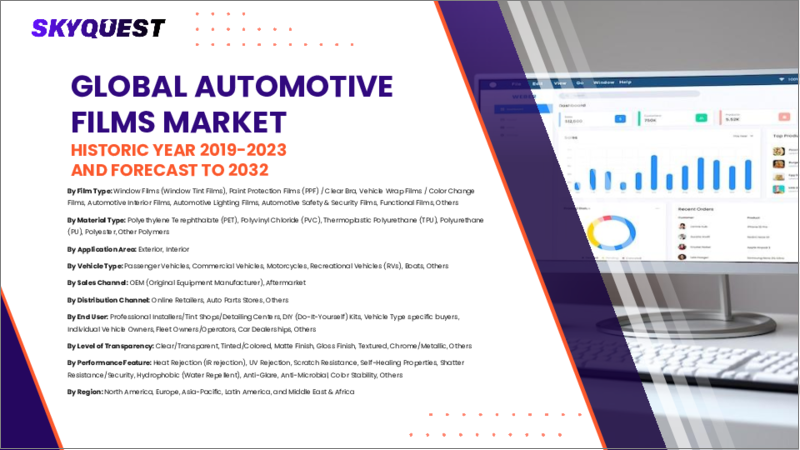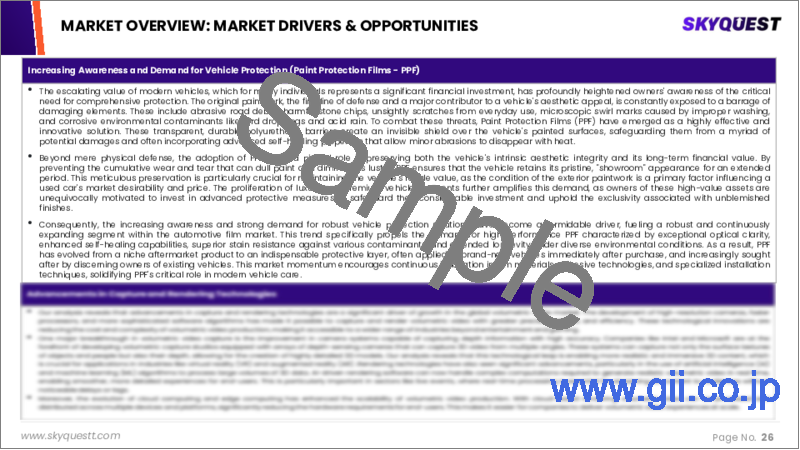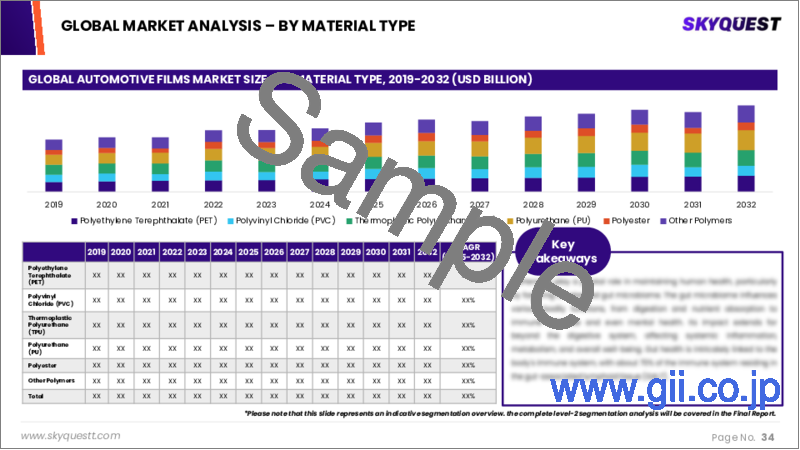|
|
市場調査レポート
商品コード
1654083
自動車用フィルムの市場規模、シェア、成長分析:タイプ別、用途別、車両別、地域別 - 産業予測 2025~2032年Automotive Film Market Size, Share, and Growth Analysis, By Type (Automotive Window Film, Automotive Wrap Films), By Application (Interior, Exterior), By Vehicle, By Region - Industry Forecast 2025-2032 |
||||||
|
|||||||
| 自動車用フィルムの市場規模、シェア、成長分析:タイプ別、用途別、車両別、地域別 - 産業予測 2025~2032年 |
|
出版日: 2025年02月10日
発行: SkyQuest
ページ情報: 英文 223 Pages
納期: 3~5営業日
|
全表示
- 概要
- 目次
自動車用フィルム2023年の市場規模は84億米ドルで、2024年の90億7,000万米ドルから2032年には167億9,000万米ドルに成長する見通しであり、予測期間(2025-2032年)のCAGRは8.0%です。
自動車用フィルムの世界市場は、これらのフィルムが提供する様々な利点に対する消費者の意識の高まりに後押しされ、力強い成長を遂げています。主に、自動車用フィルムは自動車の美観を向上させ、プライバシーを確保し、日焼けやまぶしさから保護すると同時に、内装を保護します。消費者が運転の快適性とエネルギー効率を優先する中、これらのフィルムに対する需要は依然として強いです。メーカー各社は、規制を遵守しながら機能性とデザインのバランスを確保するために、製品ラインを革新することで対応しています。技術の進歩により、遮熱やセキュリティ強化オプションなどの高性能フィルムが開発されています。競合情勢はダイナミックであり、数多くの企業が多様な製品と取り付けサービスを提供しています。自動車のカスタマイズ動向の高まりを受けて、市場は今後数年間、継続的な成長を遂げる構えです。
目次
イントロダクション
- 調査の目的
- 調査範囲
- 定義
調査手法
- 情報調達
- 二次と一次データの方法
- 市場規模予測
- 市場の前提条件と制限
エグゼクティブサマリー
- 世界市場の見通し
- 供給と需要の動向分析
- セグメント別機会分析
市場力学と見通し
- 市場概要
- 市場規模
- 市場力学
- 促進要因と機会
- 抑制要因と課題
- ポーターの分析
主な市場の考察
- 重要成功要因
- 競合の程度
- 主な投資機会
- 市場エコシステム
- 市場の魅力指数(2024年)
- PESTEL分析
- マクロ経済指標
- バリューチェーン分析
- 価格分析
自動車用フィルム市場規模:タイプ別& CAGR(2025-2032)
- 市場概要
- 自動車用ウィンドウフィルム
- 自動車ラップフィルム
- ペイント保護フィルム
自動車用フィルム市場規模:用途別& CAGR(2025-2032)
- 市場概要
- 内装
- 外観
自動車用フィルム市場規模:車両別& CAGR(2025-2032)
- 市場概要
- 乗用車
- 商用車
自動車用フィルム市場規模:地域別& CAGR(2025-2032)
- 北米
- 米国
- カナダ
- 欧州
- ドイツ
- スペイン
- フランス
- 英国
- イタリア
- その他欧州地域
- アジア太平洋地域
- 中国
- インド
- 日本
- 韓国
- その他アジア太平洋地域
- ラテンアメリカ
- ブラジル
- その他ラテンアメリカ地域
- 中東・アフリカ
- GCC諸国
- 南アフリカ
- その他中東・アフリカ
競合情報
- 上位5社の比較
- 主要企業の市場ポジショニング(2024年)
- 主な市場企業が採用した戦略
- 最近の市場動向
- 企業の市場シェア分析(2024年)
- 主要企業の企業プロファイル
- 企業の詳細
- 製品ポートフォリオ分析
- 企業のセグメント別シェア分析
- 収益の前年比比較(2022-2024)
主要企業プロファイル
- 3M(US)
- Avery Dennison(US)
- Eastman Chemical(US)
- Saint-Gobain(France)
- Toray Industries(Japan)
- Johnson Window Films(US)
- Hexis(France)
- Oracal(Germany)
- Garware Polyester(India)
- Madico(US)
- XPEL(US)
- SunTek(US)
- LLumar(US)
- Vvivid Vinyl(US)
- KPMF(US)
- Arlon Graphics(US)
- Global Films(US)
結論と提言
Automotive Film Market size was valued at USD 8.4 billion in 2023 and is poised to grow from USD 9.07 billion in 2024 to USD 16.79 billion by 2032, growing at a CAGR of 8.0% during the forecast period (2025-2032).
The global automotive films market is experiencing robust growth, fueled by heightened consumer awareness of the various advantages these films offer. Primarily, automotive films enhance vehicle aesthetics, provide privacy, and protect against sun damage and glare, while also preserving interiors. As consumers prioritize driving comfort and energy efficiency, the demand for these films remains strong. Manufacturers are responding by innovating their product lines to ensure a balance of functionality and design while adhering to regulations. Technological advancements have led to the development of high-performance films, including heat rejection and security-enhancing options. The competitive landscape is dynamic, with numerous players offering diverse products and installation services. With increasing trends in automotive customization, the market is poised for continued growth in the coming years.
Top-down and bottom-up approaches were used to estimate and validate the size of the Automotive Film market and to estimate the size of various other dependent submarkets. The research methodology used to estimate the market size includes the following details: The key players in the market were identified through secondary research, and their market shares in the respective regions were determined through primary and secondary research. This entire procedure includes the study of the annual and financial reports of the top market players and extensive interviews for key insights from industry leaders such as CEOs, VPs, directors, and marketing executives. All percentage shares split, and breakdowns were determined using secondary sources and verified through Primary sources. All possible parameters that affect the markets covered in this research study have been accounted for, viewed in extensive detail, verified through primary research, and analyzed to get the final quantitative and qualitative data.
Automotive Film Market Segments Analysis
Global Automotive Film Market is segmented by Type, Application, Vehicle and region. Based on Type, the market is segmented into Automotive Window Film, Automotive Wrap Films and Paint Protection Films. Based on Application, the market is segmented into Interior and Exterior. Based on Vehicle, the market is segmented into Passenger Vehicles and Commercial Vehicles. Based on region, the market is segmented into North America, Europe, Asia Pacific, Latin America and Middle East & Africa.
Driver of the Automotive Film Market
The automotive film market is experiencing significant growth due to the increasing interest in vehicle customization among consumers. These films present a cost-effective and convenient option for individuals looking to personalize their cars with distinctive colors, patterns, and styles that reflect their unique personalities and lifestyles. The desire for bespoke vehicles is a central factor propelling this market forward. Moreover, customization extends beyond aesthetic appeal; it can also improve vehicle performance by allowing modifications to critical components such as the engine, exhaust, brakes, and suspension. This dual appeal further solidifies automotive films as a popular choice among vehicle enthusiasts.
Restraints in the Automotive Film Market
The automotive film market faces several constraints due to the high installation costs associated with specialized tools and expertise required for the process, which may discourage potential buyers. Installation expenses vary widely based on the type of film selected, the size of the vehicle, and the geographical location of the service provider. Premium films, such as ceramic or carbon, tend to be more expensive compared to standard options. Additionally, regional tint regulations and the desired shade can further influence pricing. While higher-quality films offer enhanced protection and longevity, they typically come with a steeper price tag. The size of the vehicle also impacts the quantity of film needed, thus increasing overall costs, alongside the fact that custom installation techniques are often costlier than using pre-cut kits. Collectively, these elements create a complex pricing environment within the automotive film installation sector.
Market Trends of the Automotive Film Market
The automotive film market is witnessing a significant trend towards the adoption of advanced ceramic films, driven by rising consumer awareness and demand for enhanced vehicle comfort and aesthetics. These films are distinguished by their use of innovative ceramic nanoparticle technology, which delivers superior heat rejection, UV protection, and glare reduction while preserving high visibility. This growing preference for ceramic films reflects a broader shift in the market towards high-performance, multifunctional solutions that blend functionality with style. As automotive manufacturers and consumers alike prioritize quality and comfort, the demand for advanced ceramic films is expected to accelerate, further shaping the industry's landscape.
Table of Contents
Introduction
- Objectives of the Study
- Scope of the Report
- Definitions
Research Methodology
- Information Procurement
- Secondary & Primary Data Methods
- Market Size Estimation
- Market Assumptions & Limitations
Executive Summary
- Global Market Outlook
- Supply & Demand Trend Analysis
- Segmental Opportunity Analysis
Market Dynamics & Outlook
- Market Overview
- Market Size
- Market Dynamics
- Drivers & Opportunities
- Restraints & Challenges
- Porters Analysis
- Competitive rivalry
- Threat of substitute
- Bargaining power of buyers
- Threat of new entrants
- Bargaining power of suppliers
Key Market Insights
- Key Success Factors
- Degree of Competition
- Top Investment Pockets
- Market Ecosystem
- Market Attractiveness Index, 2024
- PESTEL Analysis
- Macro-Economic Indicators
- Value Chain Analysis
- Pricing Analysis
Global Automotive Film Market Size by Type & CAGR (2025-2032)
- Market Overview
- Automotive Window Film
- Automotive Wrap Films
- Paint Protection Films
Global Automotive Film Market Size by Application & CAGR (2025-2032)
- Market Overview
- Interior
- Exterior
Global Automotive Film Market Size by Vehicle & CAGR (2025-2032)
- Market Overview
- Passenger Vehicles
- Commercial Vehicles
Global Automotive Film Market Size & CAGR (2025-2032)
- North America (Type, Application, Vehicle)
- US
- Canada
- Europe (Type, Application, Vehicle)
- Germany
- Spain
- France
- UK
- Italy
- Rest of Europe
- Asia Pacific (Type, Application, Vehicle)
- China
- India
- Japan
- South Korea
- Rest of Asia-Pacific
- Latin America (Type, Application, Vehicle)
- Brazil
- Rest of Latin America
- Middle East & Africa (Type, Application, Vehicle)
- GCC Countries
- South Africa
- Rest of Middle East & Africa
Competitive Intelligence
- Top 5 Player Comparison
- Market Positioning of Key Players, 2024
- Strategies Adopted by Key Market Players
- Recent Developments in the Market
- Company Market Share Analysis, 2024
- Company Profiles of All Key Players
- Company Details
- Product Portfolio Analysis
- Company's Segmental Share Analysis
- Revenue Y-O-Y Comparison (2022-2024)
Key Company Profiles
- 3M (US)
- Company Overview
- Business Segment Overview
- Financial Updates
- Key Developments
- Avery Dennison (US)
- Company Overview
- Business Segment Overview
- Financial Updates
- Key Developments
- Eastman Chemical (US)
- Company Overview
- Business Segment Overview
- Financial Updates
- Key Developments
- Saint-Gobain (France)
- Company Overview
- Business Segment Overview
- Financial Updates
- Key Developments
- Toray Industries (Japan)
- Company Overview
- Business Segment Overview
- Financial Updates
- Key Developments
- Johnson Window Films (US)
- Company Overview
- Business Segment Overview
- Financial Updates
- Key Developments
- Hexis (France)
- Company Overview
- Business Segment Overview
- Financial Updates
- Key Developments
- Oracal (Germany)
- Company Overview
- Business Segment Overview
- Financial Updates
- Key Developments
- Garware Polyester (India)
- Company Overview
- Business Segment Overview
- Financial Updates
- Key Developments
- Madico (US)
- Company Overview
- Business Segment Overview
- Financial Updates
- Key Developments
- XPEL (US)
- Company Overview
- Business Segment Overview
- Financial Updates
- Key Developments
- SunTek (US)
- Company Overview
- Business Segment Overview
- Financial Updates
- Key Developments
- LLumar (US)
- Company Overview
- Business Segment Overview
- Financial Updates
- Key Developments
- Vvivid Vinyl (US)
- Company Overview
- Business Segment Overview
- Financial Updates
- Key Developments
- KPMF (US)
- Company Overview
- Business Segment Overview
- Financial Updates
- Key Developments
- Arlon Graphics (US)
- Company Overview
- Business Segment Overview
- Financial Updates
- Key Developments
- Global Films (US)
- Company Overview
- Business Segment Overview
- Financial Updates
- Key Developments





